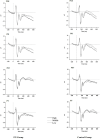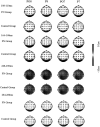Preference for ugly faces? -A cognitive study of attentional and memorial biases toward facial information among young females with facial dissatisfaction
- PMID: 36405166
- PMCID: PMC9668061
- DOI: 10.3389/fpsyg.2022.1024197
Preference for ugly faces? -A cognitive study of attentional and memorial biases toward facial information among young females with facial dissatisfaction
Abstract
Dissatisfaction with facial appearance is one of the strongest contributors to body image disturbance among young Chinese females and leads to a series of psychological and behavioral disorders. By conducting behavioral and ERP experiments, this study illustrates how young females in China with facial dissatisfaction process different levels of facial attractiveness. Experiments 1 and 2 are behavioral experiments in which the dot-probe paradigm was used to explore the participant's attentional bias to facial attractiveness. The results showed that regardless of whether the face image was presented above or below the threshold, young females with facial dissatisfaction exhibited attentional orientation toward lowly attractive faces and attentional avoidance to both lowly and highly attractive faces, while the control group showed difficulty in attentional disengagement from highly attractive faces. In experiment 3, the learning-recognition task was used to examine mnemonic bias toward facial attractiveness among females with facial dissatisfaction, and EEG data were also recorded during the encoding and retrieval phases. The study found that young females with facial dissatisfaction exhibited a mnemonic preference for lowly attractive images at both the encoding and retrieving stages, with higher P1, N170, P2, and N300 induced by lowly attractive faces, while the control group preferred highly attractive faces. In conclusion, young females with facial dissatisfaction tend to exhibit attentional orientation and mnemonic bias toward lowly attractive faces.
Keywords: behavioral experiments & ERP experiments; cognitive bias; facial attractiveness; facial dissatisfaction; young females.
Copyright © 2022 Zhu, Zhou, Wang, Ma and Liu.
Conflict of interest statement
The authors declare that the research was conducted in the absence of any commercial or financial relationships that could be construed as a potential conflict of interest.
Figures






Similar articles
-
Attentional Biases toward Face-Related Stimuli among Face Dissatisfied Women: Orienting and Maintenance of Attention Revealed by Eye-Movement.Front Psychol. 2016 Jun 27;7:919. doi: 10.3389/fpsyg.2016.00919. eCollection 2016. Front Psychol. 2016. PMID: 27445892 Free PMC article.
-
Neural correlates of the attentional bias towards pain-related faces in fibromyalgia patients: An ERP study using a dot-probe task.Neuropsychologia. 2022 Feb 10;166:108141. doi: 10.1016/j.neuropsychologia.2021.108141. Epub 2022 Jan 4. Neuropsychologia. 2022. PMID: 34995568
-
Gender differences in memory processing of female facial attractiveness: evidence from event-related potentials.Neurocase. 2016 Jun;22(3):317-23. doi: 10.1080/13554794.2016.1151532. Epub 2016 Feb 29. Neurocase. 2016. PMID: 26928269
-
Mechanisms for the Cognitive Processing of Attractiveness in Adult and Infant Faces: From the Evolutionary Perspective.Front Psychol. 2020 Mar 11;11:436. doi: 10.3389/fpsyg.2020.00436. eCollection 2020. Front Psychol. 2020. PMID: 32218762 Free PMC article. Review.
-
Event-related potentials of attentional bias toward faces in the dot-probe task: A systematic review.Psychophysiology. 2018 Jun;55(6):e13051. doi: 10.1111/psyp.13051. Epub 2017 Dec 20. Psychophysiology. 2018. PMID: 29266532
Cited by
-
Recognition Mechanism of Dangerous Goods Marks: Evidence from an Event-Related Potential Study.Int J Environ Res Public Health. 2023 Mar 15;20(6):5192. doi: 10.3390/ijerph20065192. Int J Environ Res Public Health. 2023. PMID: 36982102 Free PMC article.
References
-
- Atari M., Chegeni R., Fathi L. (2017). Women who are interested in cosmetic surgery want it all: the association between considering cosmetic surgery and women’s mate preferences. Adapt. Hum. Behav. Physiol. 3, 61–70. doi: 10.1007/s40750-016-0053-9 - DOI
LinkOut - more resources
Full Text Sources

